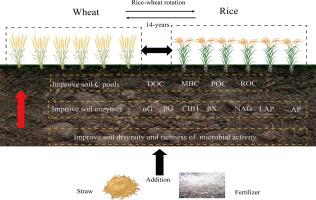Science of the Total Environment ( IF 8.2 ) Pub Date : 2022-06-11 , DOI: 10.1016/j.scitotenv.2022.156608 Bo Liu 1 , Hao Xia 2 , Cuncang Jiang 3 , Muhammad Riaz 4 , Li Yang 1 , Yunfeng Chen 1 , Xianpeng Fan 1 , Xiange Xia 1

|
Traditional fertilization management can damage soil structure and lead to severe soil erosion. The practice of crop straw returning to the field reduces the negative impact of straw burning and improves soil quality. We investigated the effects of these agricultural practices on soil organic carbon components, enzyme activities, and soil microorganisms over 14 years of field experiments. Specifically, we studied four management strategies: no fertilizer or crop straw returning (CK), traditional chemical fertilization (NPK), crop straw returning (S), and crop straw returning with chemical fertilizer (NPKS). We found NPKS treatments significantly (P < 0.05) increased the dissolved organic carbon (DOC), microbial biomass carbon (MBC), particulate organic carbon (POC) and readily oxidized organic carbon (ROC) concentrations by 79.32 %, 82.16 %, 92.46 %, and 104.32 % relative to CK. Furthermore, under NPKS, the activities of soil enzymes related C, N, and P (α-glucosidase (αG), β-glucosidase (βG), cellulase (CBH), xylanase (βX), acetyl β-glucosaminidase (NAG), leucine aminopeptidase (LAP), and acid phosphate (AP)) were increased by 54.66 %, 113.26 %, 76.73 %, 52.41 %, 45.74 %, 56.69 %, and 68.92 % relative to CK, respectively.. Redundancy analysis and structural equation modelling showed that straw returning had positive effects on soil microbial community diversity and richness, and also improved microbial activity which is favorable in the degradation of soil carbon. Furthermore, we found that soil fungi were more sensitive than bacteria to changes in soil carbon composition and enzyme activities following straw returning. These results suggest that straw returning combined with chemical fertilizer can be an effective strategy to improve soil labile organic carbon components, enzyme activities, and ecological function of microorganisms.
中文翻译:

14年施用化肥和农作物秸秆对华中稻麦轮作土壤不稳定有机碳组分、酶活性和微生物群落的影响
传统的施肥管理会破坏土壤结构并导致严重的水土流失。农作物秸秆还田的做法减少了秸秆焚烧的负面影响,改善了土壤质量。我们在 14 年的田间试验中调查了这些农业实践对土壤有机碳成分、酶活性和土壤微生物的影响。具体而言,我们研究了四种管理策略:不施肥或秸秆还田(CK)、传统化学施肥(NPK)、秸秆还田(S)和秸秆化肥还田(NPKS)。我们发现 NPKS 治疗显着 ( P < 0.05) 使溶解有机碳 (DOC)、微生物生物质碳 (MBC)、颗粒有机碳 (POC) 和易氧化有机碳 (ROC) 浓度相对于 CK 增加 79.32 %、82.16 %、92.46 % 和 104.32 % . 此外,在 NPKS 下,与 C、N 和 P 相关的土壤酶活性(α-葡萄糖苷酶(αG)、β-葡萄糖苷酶(βG)、纤维素酶(CBH)、木聚糖酶(βX)、乙酰β-氨基葡萄糖苷酶(NAG)、相对于 CK,亮氨酸氨基肽酶 (LAP) 和酸性磷酸 (AP) 分别增加了 54.66%、113.26%、76.73%、52.41%、45.74%、56.69% 和 68.92%。冗余分析和结构方程建模表明秸秆还田对土壤微生物群落多样性和丰富度有积极影响,同时也提高了有利于土壤碳降解的微生物活性。此外,我们发现土壤真菌比细菌对秸秆还田后土壤碳成分和酶活性的变化更敏感。这些结果表明秸秆还田与化肥相结合是提高土壤不稳定有机碳成分、酶活性和微生物生态功能的有效策略。













































 京公网安备 11010802027423号
京公网安备 11010802027423号